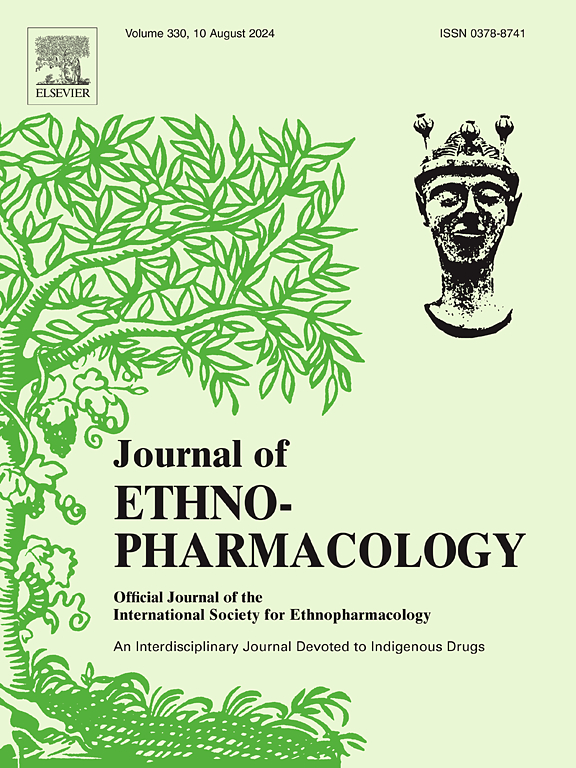Improvement effect of Shengxian Decoction on cardiac toxicity induced by arsenic trioxide in rats
IF 5.4
2区 医学
Q1 CHEMISTRY, MEDICINAL
引用次数: 0
Abstract
Ethnopharmacological relevance
Shengxian Decoction (SXD), first documented by Zhang Xichun in the Yi Xue Zhong Zhong Can Xi Lu, has been traditionally utilized to treat cardiovascular conditions such as coronary atherosclerosis and cardiomyopathy. However, the precise pharmacological mechanisms underlying its therapeutic effects remain to be fully elucidated.
Aim of the study: Arsenic trioxide (ATO) induces significant cardiotoxicity during clinical treatment, manifesting as dose-dependent QT interval prolongation, severe ventricular arrhythmias, such as torsades de pointes (TdP). While SXD demonstrates favorable clinical effects in cardiovascular disease treatment, its influence on ATO-induced cardiotoxicity has not been determined. The present investigation seeks to clarify the cardioprotective potential of SXD and uncover its mechanistic basis in a rat model subjected to ATO-induced myocardial toxicity.
Materials and methods
The principal chemical components present in SXD were identified by employing HPLC analysis. Sprague-Dawley rats were treated with SXD first and then ATO was administered 6h later for a period of 15 days. During the course of the experiment, animal weight and food intake were documented. ECG was employed to evaluate cardiac function, and myocardial damage was assessed by applying H&E and Masson's trichrome staining protocols. The ultrastructural morphology of mitochondria was examined using transmission electron microscopy. ROS levels and SOD, CAT, GSH, MDA in myocardial tissue were quantified. Serum cardiac biomarkers (LDH, CK, cTnI) were measured. ELISA was employed to quantify the levels of pro-inflammatory cytokines (IL-1β, IL-6, TNF-α). The expression of apoptosis-related proteins (Bax, Bcl-2, cleaved caspase-3, caspase-3) and of key regulators within the AMPK/SIRT1/PGC-1α signaling axis (AMPKα2, p-AMPKα2, SIRT1, PGC-1α, and NF-κB) was analyzed via Western blotting.
Results
The findings demonstrated that SXD administration mitigated ECG abnormalities and reduced pathological damage induced by ATO. SXD treatment reduced ROS generation, increased enzymatic bioactivities of SOD, CAT, and GSH, lowered MDA levels, and further reduced the serum concentrations of LDH, CK, and cTnI. Moreover, SXD treatment downregulated the expression of pro-inflammatory cytokines, including IL-1β, IL-6, and TNF-α. The expression levels of Bax, Cleaved caspase-3, and Caspase-3 declined, whereas Bcl-2 expression was elevated. SXD alleviated ATO-mediated inhibition of the AMPK/SIRT1/PGC-1α axis and suppressed NF-κB pathway activation.
Conclusions
SXD may alleviate ATO-induced cardiotoxicity by mitigating oxidative damage, inflammatory responses, and programmed cell death, potentially through upregulation of the AMPK/SIRT1/PGC-1α axis.

生仙汤对三氧化二砷致大鼠心脏毒性的改善作用。
民族药理学相关性:生仙汤最早由张锡春在《易学中中参西录》中记载,传统上用于治疗冠心病、心肌病等心血管疾病。然而,其治疗作用的确切药理机制仍有待充分阐明。研究目的:三氧化二砷(ATO)在临床治疗过程中会引起明显的心脏毒性,表现为剂量依赖性QT间期延长,严重的室性心律失常,如点扭转(TdP)。虽然SXD在心血管疾病治疗中表现出良好的临床效果,但其对ato诱导的心脏毒性的影响尚未确定。本研究旨在阐明SXD的心脏保护潜力,并揭示其在ato诱导心肌毒性大鼠模型中的机制基础。材料和方法:采用高效液相色谱法对药材中主要化学成分进行鉴定。Sprague-Dawley大鼠先给予SXD, 6h后给予ATO,连续15 d。实验过程中记录动物体重和摄食量。采用心电法评估心功能,采用H&E和Masson三色染色法评估心肌损伤。透射电镜观察线粒体超微结构形态。测定心肌组织中ROS水平及SOD、CAT、GSH、MDA水平。检测血清心脏生物标志物(LDH、CK、cTnI)。ELISA法测定促炎因子(IL-1β、IL-6、TNF-α)水平。Western blotting分析凋亡相关蛋白(Bax、Bcl-2、cleaved caspase-3、caspase-3)和AMPK/SIRT1/PGC-1α信号轴关键调控因子(AMPKα2、p-AMPKα2、SIRT1、PGC-1α、NF-κB)的表达。结果:SXD能减轻ATO引起的心电异常和病理损害。SXD处理减少了ROS的产生,增加了SOD、CAT和GSH的酶生物活性,降低了MDA水平,进一步降低了血清LDH、CK和cTnI的浓度。此外,SXD治疗下调了促炎细胞因子的表达,包括IL-1β、IL-6和TNF-α。Bax、Cleaved caspase-3和caspase-3的表达水平下降,而Bcl-2的表达水平升高。SXD减轻了ato介导的AMPK/SIRT1/PGC-1α轴的抑制,抑制了NF-κB通路的激活。结论:SXD可能通过上调AMPK/SIRT1/PGC-1α轴,减轻氧化损伤、炎症反应和程序性细胞死亡,从而减轻ato诱导的心脏毒性。
本文章由计算机程序翻译,如有差异,请以英文原文为准。
求助全文
约1分钟内获得全文
求助全文
来源期刊

Journal of ethnopharmacology
医学-全科医学与补充医学
CiteScore
10.30
自引率
5.60%
发文量
967
审稿时长
77 days
期刊介绍:
The Journal of Ethnopharmacology is dedicated to the exchange of information and understandings about people''s use of plants, fungi, animals, microorganisms and minerals and their biological and pharmacological effects based on the principles established through international conventions. Early people confronted with illness and disease, discovered a wealth of useful therapeutic agents in the plant and animal kingdoms. The empirical knowledge of these medicinal substances and their toxic potential was passed on by oral tradition and sometimes recorded in herbals and other texts on materia medica. Many valuable drugs of today (e.g., atropine, ephedrine, tubocurarine, digoxin, reserpine) came into use through the study of indigenous remedies. Chemists continue to use plant-derived drugs (e.g., morphine, taxol, physostigmine, quinidine, emetine) as prototypes in their attempts to develop more effective and less toxic medicinals.
 求助内容:
求助内容: 应助结果提醒方式:
应助结果提醒方式:


